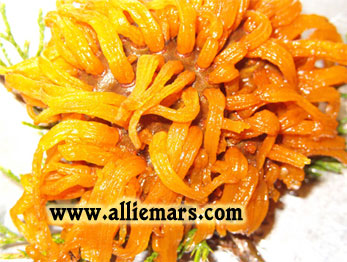 Bright orange many-tentacled creatures covered the tree like ornaments on a Christmas tree. They looked just like sea anemones you find in the ocean but these were growing all over our cedar tree.
Bright orange many-tentacled creatures covered the tree like ornaments on a Christmas tree. They looked just like sea anemones you find in the ocean but these were growing all over our cedar tree.
We’d never seen anything like it and we watched our cedar tree for days as the orange tentacled blobs sat unmoving on the branches. Were they fungi? Were they animal? Did they come from outer space? No sixties hippie acid trip could have envisioned such an out-of-this-world entity.
Eventually they dried up and disappeared and we were left to search the internet for “bright orange tentacled fungus” and “orange tree fungus” and other variants before we hit upon photos that matched our own. We’d taken several photos of our tree blobs before they’d disintegrated.
The culprit turned out to be a tree rust called Gymnosporangium juniperi-virginianae, a rust fungus known commonly as Cedar-Apple Rust. A parasitic entity appearing throughout eastern North America in the spring, Cedar-Apple Rust attacks cedar trees and apple trees. The scientific name translates into “naked spore-bearer of the Eastern Juniper Tree”.
It’s a complicated parasite needing two different hosts to complete its life cycle, spending its inconspicuous stage on the apple tree appearing as bright orange or yellow spots on the leaves, then migrating to the cedar tree for the big show. The tentacled fruiting body then produces spore horns (the tentacles) which send spores back to the apple tree to start the cycle again. Dried up galls are left on the cedar tree to overwinter awaiting the spring rains to begin the cycle again.
To determine if a gall is still active, place it in a cup of water. If tentacles appear you know it’s still alive and kicking.
While the sight of these tentacled creatures is truly amazing, a cedar tree covered with this rust indicates serious problems with nearby apple trees. If you have apple trees or crabapple trees being damaged by this fungus, the best combat is to remove any cedars within a five mile radius to break the life cycle. Removing cedars within a two mile radius will only allow you to control the rust with a fungacide.
The bright orange tree blob is featured in the book “The Wizard of Awe: An Acre of America Backyard Nature Series” which is a back yard travelog with photos and stories. These books are all available on Kindle and paperback.























How can you get rid of these from the evergreens so they don’t contaminate the apple trees?